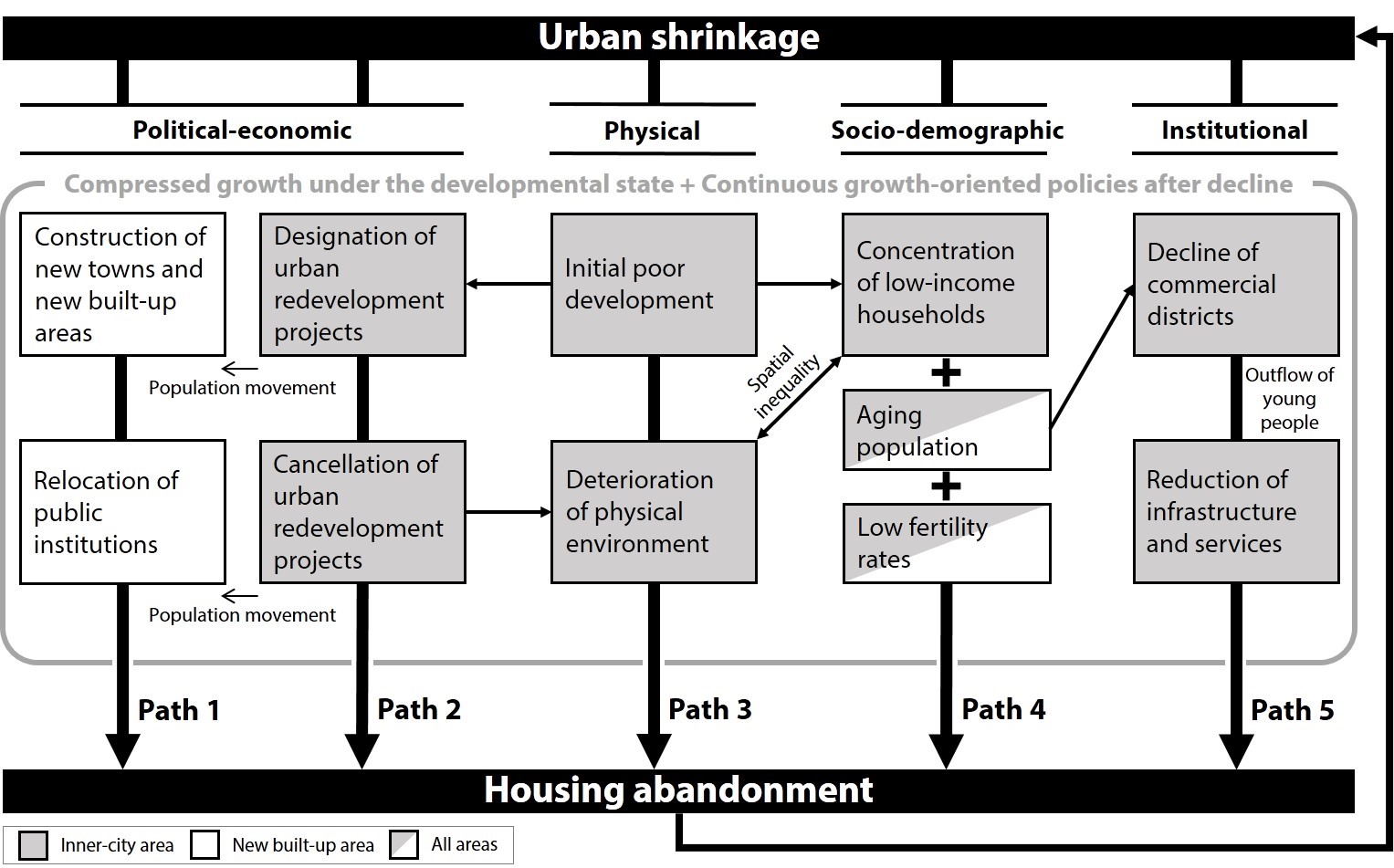Housing abandonment in shrinking cities of East Asia: Case study in Incheon, South Korea
Blog by Youngmee Jeon and Saehoon Kim
- Created
- 9 Jul 2019, 9:15 a.m.
- Author
- Youngmee Jeon and Saehoon Kim
- DOI
- 10.1177/0042098019852024
Abstract: https://journals.sagepub.com/doi/full/10.1177/0042098019852024#abstract
In many parts of the world, housing abandonment in shrinking cities has been debated extensively among scholars, designers, urban planners, policy makers and residents. In recent years, this issue has become increasingly important in many cities of East Asian countries, which have been typified by the image of rapid economic growth under the strong developmental regime but are now suffering from population losses, aging societies, obsolete buildings and infrastructure, an outflow of facilities and the failure of urban regeneration programs. It is necessary to understand the dynamics of vacant houses based on local context, according to the complex and multifaceted nature of urban shrinkage, to address them appropriately. Until now, however, most shrinking cities in East Asia, including Korea, have adopted alternatives that are derived from the United States and European cases or that are just suitable for growing cities, without precise investigation of the causes and patterns of housing abandonment.
This study attempts to understand urban factors associated with housing abandonment and shrinkage based on the context of inner-city areas of Incheon, South Korea. The case study of Incheon exemplifies how serious the shrinkage of inner-city areas in a large city is, which has not been noticed due to the city’s overall growth. We establish a comprehensive and meaningful theoretical framework utilizing a literature review and field survey to explain five paths of housing abandonment in shrinking cities, which concentrate on main triggers that have impacts on vacant houses.
Path 1 relates to the state-led construction of new towns and new built-up areas with the relocation of public institutions, pulling residents out of inner-city areas. Path 2 is associated with the delay and cancellation of numerous urban redevelopment projects designated in inner-city areas, pushing residents to new built-up areas. Paths 1 and 2 have resulted from the extensive state intervention in urban planning, which is a distinctive characteristic of land and housing development in East Asia. Path 3 concerns the buildings’ initially inferior construction, causing the accelerated deterioration of physical environment and the concentration of low-income group. This path is mainly due to the rapid urbanization process under compressed growth and is primarily observed in inner-city areas of Korea’s metropolitan cities like Incheon and Busan. Path 4 addresses social problems involving the concentration of aged populations and their deaths, such as devastated communities. The extreme concentration of population in metropolitan areas still found in East Asian countries and severely depressed birthrate have accelerated the aging of old urban centers. Path 5 is related to the reduction of infrastructure and services in the process of deepened decline, predicting the degradation of quality of life for the remaining people as well as the desolation of inner-city areas. This phenomenon of irreversible spatial disparity is also found in the cities of Kanagawa, Saitama, and Gunma Prefecture of the Tokyo metropolitan area. Since the paths are closely inter-related and simultaneously exercise their influence in reality, the aspects of housing abandonment are also expected to vary depending on the combination of the paths.
The study provides an opportunity to explore different paths of housing abandonment of East Asia, as distinct from those of the West. The results of our study raise several policy issues for vacant houses in shrinking cities. First, since housing abandonment is directly or indirectly affected by the construction of adjacent new built-up areas, vacant house related policies need to be considered in connection with comprehensive urban growth management policies. Second, the designation of excessive urban redevelopment district that can mass-produce vacant houses in declining inner cities, especially in Korea, should be avoided. Third, it is proposed to establish a system that can keep track of buildings with a high possibility of conversion to vacant houses, such as the poorest quality housing where elderly owners live alone. Lastly, in respect of the downsizing of public facilities and services in disadvantaged areas, a long-term perspective and concrete plans are required to prevent the vicious cycle.
Figure 1. A theoretical framework for explaining five paths associated with an increase in the number of vacant houses in shrinking cities.
Read the accompanying paper Housing abandonment in shrinking cities of East Asia: Case study in Incheon, South Korea on Urban Studies - Online First.



Comments
You need to be logged in to make a comment. Please Login or Register
There are no comments on this resource.